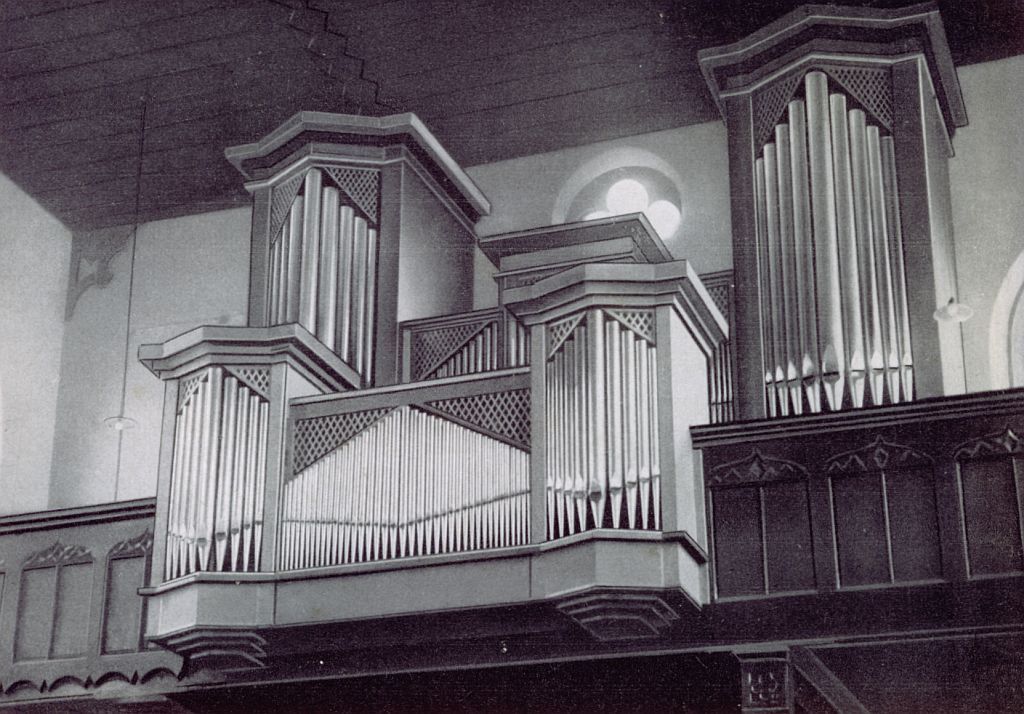Ausführliche Beschreibung der vorgewählten Orgel

Bild: Gebrüder Späth
Dannstadt (Pfalz), Deutschland (Rheinland-Pfalz) - Katholische Pfarrkirche Sankt Michael
Gemeinde: Dannstadt-Schauernheim
Adresse: Kirchenstraße 6, 67125, Dannstadt
Website: https://www.hl-sebastian.de/
Beschreibung nr.: 2022304.
Gebaut von: Gebrüder Späth (1956) - Opus 632
Technische Daten
Disposition
Hauptwerk: Prinzipal 8', Großgedackt 8', Gemshorn 8', Octave 4', Gedacktflöte 4', Superoctave 2', Mixtur 4 fach (1 1/3'), Trompete 8'.
Rückpositiv: Metallgedackt 8', Feldflöte 4', Prinzipal 2', Quinte 1 1/3', Sesquialter 2 fach (2 2/3'), Cymbel 3 fach (1/2'), Tremolo.
Pedal: Subbass 16', Octavbass 8', Rohrflöte 4', Flageolet 2', Stillposaune 16'.
Koppeln: Hauptwerk - Rückpositiv, Pedal - Hauptwerk, Pedal - Rückpositiv.

Bild: Gebrüder Späth
Dannstadt (Pfalz), Deutschland (Rheinland-Pfalz) - Katholische Pfarrkirche Sankt Michael
Gemeinde: Dannstadt-Schauernheim
Adresse: Kirchenstraße 6, 67125, Dannstadt
Website: https://www.hl-sebastian.de/
Beschreibung nr.: 2022304.
Gebaut von: Gebrüder Späth (1956) - Opus 632
| Jahr | Orgelbauer | Opus | Aktivität | 1775 | Konrad Zahn | Neubau | 1867 | Emil Eichenauer | Übersetzung | 1888 | Rees & Co. | Umbau | 1911 | Franz Kämmerer | Verschiedene Tätigkeiten | 1928 | Franz Kämmerer | Umbau | 1956 | Gebrüder Späth | 632 | Umbau | 1981 | Gerhard Kuhn | Umbau |
- The organ history of the Sankt Michaelskirche in Dannstadt is a story of many renovations and adjustments. The organ was originally built in 1775 (but Bonkhoff also mentions 1757, possibly a mistake?) by Conrad Zahn. It had nine stops on the manual and two on the pedal, according to the contract. The organ replaced an old positive with five stops.
- After the construction of a new church, the organ was transferred by the company Eichenauer from Speyer. This would have happened in 1867 or in 1886. In 1888 the company Rees & Co. carried out renovation works. The compass of the manual was changed from 52 keys (CD-e''') to 54 keys (C-f''') and the compass of the pedal from seventeen keys (CD-f°) to 27 keys (C- d'). The disposition has also been changed, but it is also possible that this had already been done by Eichenauer.
- The next rebuild was carried out by Franz Kämmerer. In 1911 he replaced the pedal chest with a new pneumatic cone chest and installed a new wind motor. In 1928 he converted the organ into a two-manual organ by splitting the wind chest of the manual and dividing the ranks over the two manuals. Some new registers were also added.
- In 1956 the organ was rebuilt by the company Gebr. Späth. They constructed a new mechanical wind chest for the pedal, altered the disposition and installed a new console. The second manual was placed as Rückpositiv. In 1981 the organ was restored by Gerhard Kuhn. Eleven registers were renewed and the mechanics were rebuilt. The Rankett 16' of the Rückpositiv was replaced by a Sesquialter.
Technische Daten
| Anzahl Register pro Manual | |
| - Hauptwerk | 8 |
| - Rückpositiv | 6 |
| - Pedal | 5 |
| Gesamtzahl der Stimmen | 19 |
| Tastentraktur | Mechanical |
| Registertraktur | Mechanical |
| Windlade(n) | Slider chests |
Disposition
Hauptwerk: Prinzipal 8', Großgedackt 8', Gemshorn 8', Octave 4', Gedacktflöte 4', Superoctave 2', Mixtur 4 fach (1 1/3'), Trompete 8'.
Rückpositiv: Metallgedackt 8', Feldflöte 4', Prinzipal 2', Quinte 1 1/3', Sesquialter 2 fach (2 2/3'), Cymbel 3 fach (1/2'), Tremolo.
Pedal: Subbass 16', Octavbass 8', Rohrflöte 4', Flageolet 2', Stillposaune 16'.
Koppeln: Hauptwerk - Rückpositiv, Pedal - Hauptwerk, Pedal - Rückpositiv.
| Übrige dispositiondaten | |
|---|---|
| Mehrere dispositionen |
|
| Literatur |
Die Orgeln der Stadt und des Landkreises Ludwigshafen : Teil 1: Von Alsheim-Gronau bis Ludwigshafen / Bernhard H. Bonkhoff. - In: Mitteilungen Nr. 72. - Mainz : Arbeitsgemeinschaft für mittelrheinische Musikgeschichte, 2001. |
